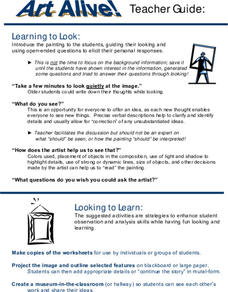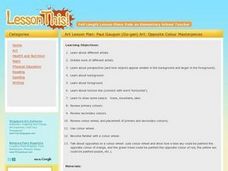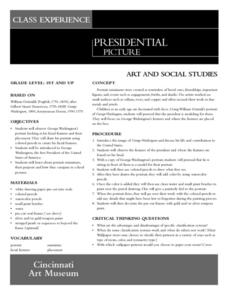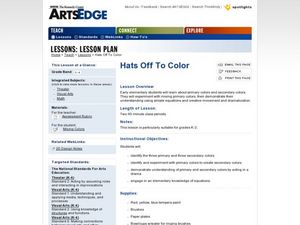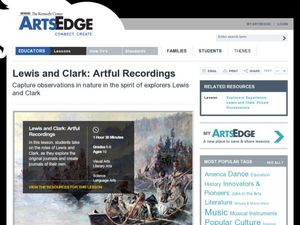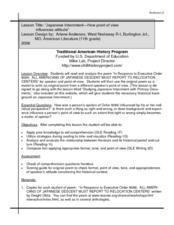Gilder Lehrman Institute of American History
Harriet Beecher Stowe Sends Uncle Tom’s Cabin to Victoria and Albert, 1852
Harriet Beecher Stowe's plea for abolition is not only laid plain in her acclaimed novel, Uncle Tom's Cabin, but in her written correspondence as well. High schoolers read a letter written by Stowe to Prince Albert and Queen Victoria to...
EngageNY
Gathering Textual Evidence: “Invisibility” of Those Interned
Add another layer to the class's understanding. Scholars deepen their knowledge of the primary sources in their Japanese-American Internment during World War II packet and determine how the sources relate to the theme of invisibility....
Memorial Art Gallery
Art Alive! - Towing a Boat, Honfleur
Color, light and shadow, the placement and size of objects. These are some of the tools artists used to tell their stories. Model for learners how to read a painting by closely examining these features. The richly detailed packet...
Memorial Art Gallery
Art Alive! - Beach at Blue Point
And then what happened? Class members engage in a series of activities that model for them how to read the story in a painting. Participants respond to questions that ask them to closely examine the elements in William Glackens' "Beach...
Curated OER
Name Art
Students create name art. In this visual arts instructional activity, students use horizontal, vertical, and diagonal lines to highlight their own names in print. Students use primary colors to create secondary colors in the project.
Curated OER
Primary and Secondary Colors
Students explore primary and secondary colors. In this art lesson, students use jars of colored water to create the secondary colors.
Curated OER
Paul Gauguin Art: Opposite Colour Masterpieces
Students discover new art techniques by examining the work of Paul Gauguin and his use of opposite colors. In this art analysis instructional activity, students investigate the different perspectives and colors used in classic post...
Curated OER
Mondrian Inspired Abstract Art
Young scholars explore the art of Piet Mondrian. For this abstract art lesson, students look at paintings by the Dutch painter and then follow the provided steps to create their own abstract art inspired by his works.
Curated OER
Pop Art Ice Cream Painting
Pupils develop skills in painting and create a painting of an ice cream cone using Pop Art as in inspiration.
Curated OER
Memory & Song, Malagan Figures from New Ireland, Papua New Guinea
Students investigate the uses of images, shapes and colors in classic art sculptures. In this art analysis lesson plan, students observe Malagan Figures, a type of sculpture from New Guinea, and describe the different ideas and images...
Curated OER
Presidential Picture
Students create miniature portraits of George Washington using a primary source image, watercolor pencils, colored pencils and white drawing paper. This Art lesson can be used as an introductory lesson on George Washington in a U.S....
Curated OER
Hats Off to Color
Students investigate primary and secondary colors. In this art lesson, students mix primary paint colors to develop secondary colors. Students identify each color they created.
Curated OER
The Great Gatsby: Primary Sources from the Roaring Twenties
Students research the Roaring Twenties. In this 1920's America lesson, students analyze primary sources to develop an understanding of lifestyles and values of the era as they read F. Scott Fitzgerald's The Great Gatsby.
Curated OER
Spicy Hot Colors
First graders discover the importance of primary colors by reading a book in class. In this art lesson, 1st graders read the book Spicy Hot Colors, and discuss the three primary colors and the numerous combinations they can make....
Curated OER
Lewis and Clark: Artful Recordings
Students examine the nature journals of Lewis and Clark. For this primary source analysis lesson, students research the journals that the members of the Corps of Discovery kept during the expedition and then conduct further research on...
Curated OER
Nonviolence as a Tool for Change Lesson 1
Young scholars examine voting rights in the South during the 1950s and 1960s. In this civil rights lesson, students examine legal rights and the opportunity to cast votes. Young scholars research primary documents regarding the topic and...
Canadian War Museum
Comparing Primary and Secondary Sources
This simple two-day lesson plan introduces learners to the differences between primary and secondary sources. The lesson plan includes group work that explores the similarities and differences, and the advantages and disadvantages of...
Curated OER
"Sentences - Can You Make Them?"
Here is a great lesson on how to make a complete sentence. Young writers "drag and drop" the words using the mouse. This is a fantastic activity to use with "Word Wall Words." It provides practice in making sentences, as well as...
Curated OER
Japanese Internment--How Point of View Influences Attitude
How does background and experience influence one's point of view? Dwight Okita's famous poem about the Japanese internment is the text used to explore this essential question. Class members study primary documents to gain the necessary...
PBS
Standing Up Against Injustice
“Sometimes things are lawful yet are actually wrong.” Researchers examine primary and secondary source materials as they study five legal cases involving civil rights attorney William Kunstler in which he attempted to use the legal...
Alabama Department of Archives and History
Strange Fruit: Lynching in America
To continue their study of the Civil War, Reconstruction, and the beginning of the civil rights movement, class members watch the YouTube video of Billie Holiday singing "Strange Fruit" as an introduction to an examination of lynching in...
Curated OER
Character Attributes in Writing
Third graders analyze the importance of characters in fiction writing and performances. In this theatre instructional activity, 3rd graders identify the important characteristics of a fictional character and how to portray a character...
Curated OER
Why Do We Remember Revere? Paul Revere's Ride in History and Literature
Students examine primary documents regarding Paul Revere's ride and its role in the Revolutionary War. They consider how Revere's role has been written about by Longfellow and others and discuss the discrepancies between accounts.
Curated OER
About Life: The Photographs of Dorothea Lange Going to the Promised Land
To better understand the migrant experience during the Great Depression, pupils analyze two primary resources: photographs by Dorothea Lange and a U.S. Map that shows the Dust Bowl. They compare and contrast Lange's images to Steinbeck's...
Other popular searches
- Art Lessons Primary
- Art Lessons Primary Penguins
- Edible Art Lessons Primary
- Art Lessons Primary Easter
- 3d Art Lessons Primary
- Art Lessons Primary Fruit
- Winter Art Lessons Primary
- Maori Art Lessons Primary
- Visual Art Lessons Primary
- Art Lessons Primary Tiger
- Art Lessons Primary Water
- Art Lessons Primary Victoria




